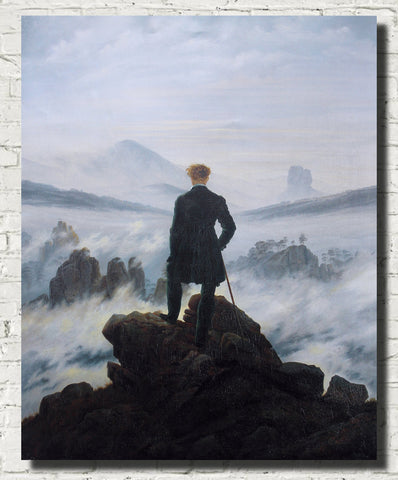Table of Contents:[hide]
Caspar David Friedrich, a luminary of the German Romantic movement, left an indelible mark on art with his masterpiece, "Wanderer above the Sea of Fog" (c. 1818). In this exploration, we delve into the layers of meaning, the artistic techniques, and the enigmatic allure of this iconic painting.
The Wanderer's Odyssey
In this evocative piece, a solitary figure stands atop a crag, surveying a landscape blanketed in mountain mist. Friedrich's protagonist, the wanderer, invites us to ponder the dichotomy of man's mastery over nature versus his insignificance within it. The composition, employing the Rückenfigur technique, beckons us to join the wanderer on his journey of contemplation.
Interpreting Ambiguity
Friedrich's landscapes often teeter on the precipice of existential contemplation. The Wanderer, with wind-tousled hair and a noble stance, leaves room for interpretation. Is he exalted by the conquest of nature, or does doubt shroud his gaze? The brilliance of Friedrich lies in crafting a scene that seamlessly oscillates between optimism and pessimism.
Nature as Allegory
Friedrich's early works, rooted in the Baltic coastlands, evolved into rich tapestries of nature imbued with crosses and religious motifs. These symbols, drawn from his strict Lutheran upbringing, added layers of allegory to his landscapes. The artist masterfully fused disparate sketches, even borrowing from other artists, to create scenes heavy with symbolism.
The Art of Composition
The construction of "Wanderer above the Sea of Fog" is a testament to Friedrich's meticulous approach. Applying the Golden Section, an aesthetic principle championed by Luca Pacioli, Friedrich divided the landscape, creating a harmonious structure. The placement of the horizon and the wanderer's figure aligns with the Golden Section, inducing a sense of exultation in the viewer.
A Journey Beyond Reality
This masterpiece, though not a literal view, is a composite of Friedrich's travels across Germany and Switzerland. The rocky hilltop, a pivotal detail, traces back to a sketch from Kaiserkrone hill. Friedrich's use of imagined scenes, cosmic in nature, prompts a paradoxical mood—noble optimism juxtaposed with terrifying loneliness.
Friedrich's Oeuvre
"Wanderer above the Sea of Fog" epitomizes Friedrich's ability to evoke profound experiences through landscape. From his early depictions of the Baltic coast to later universal explorations of spirituality, Friedrich's oeuvre transcends religious connotations. His paintings are not just journeys through physical landscapes but voyages into the depths of human contemplation.
Frequently Asked Questions about Caspar David Friedrich's "Wanderer above the Sea of Fog"
1. What is the central theme of "Wanderer above the Sea of Fog"?
- The central theme revolves around the contemplative relationship between humanity and nature, questioning whether the lone figure is a master of the landscape or a small and insignificant part of it.
2. Who is the wanderer, and what does his appearance signify?
- The wanderer is a solitary figure standing on a crag of rocks. His refined attire, including a frock coat and a walking cane, suggests an urban background, while his presence in the rugged wilderness symbolizes a deliberate immersion in nature.
3. What is the significance of the Rückenfigur technique in the painting?
- The Rückenfigur, or figure seen from behind, serves as a compositional device, inviting the viewer to identify with the scene by placing them as a silent companion behind the wanderer, sharing his contemplative perspective.
4. How can the painting be interpreted optimistically?
- An optimistic interpretation sees the wanderer as a triumphant explorer who, having conquered the precipice, stands exalted, gazing over the majestic landscape with a sense of inspiration and dignity.
5. Is there a pessimistic reading of the painting?
- Yes, a pessimistic reading suggests that the wanderer, surrounded by swirling mist and isolated in the vast landscape, may be grappling with doubt and confronting his own uncertain existence.
6. What role do sailing boats play in Friedrich's landscapes, including this painting?
- Sailing boats in Friedrich's landscapes serve as transitory elements, symbolizing fleeting moments. They appear in the distance, encouraging silent yearning and contemplation for the gazing figures.
7. How does Friedrich's background influence the themes in his paintings?
- Friedrich's Lutheran upbringing is reflected in early works featuring religious motifs. However, his later paintings delve into universal themes, exploring the spiritual side of humankind facing the mystery and loneliness of vast landscapes.
8. Is the scene in "Wanderer above the Sea of Fog" based on a real view?
- While the painting is not a real view, it is a meticulously constructed amalgamation of different locations visited by Friedrich during his sketching travels across Germany and Switzerland.
9. What is the Golden Section, and how is it applied in the composition?
- The Golden Section is a principle of aesthetic harmony. In the painting, Friedrich divides the landscape into two parts above and below the horizon, following the mathematical ratio, and positions elements such as ridges and the wanderer in alignment with this principle.
10. How does the painting induce paradoxical emotions?
- The composition, with its calculated arrangement guided by the Golden Section, creates a sense of exultation and loneliness simultaneously. The painting becomes a visual paradox, invoking noble optimism and terrifying solitude.
Prints and Canvas Panels
Enjoy your own view of "Wanderer above the sea of fog" with a fine art print or canvas panel - both available in a range of sizes.


